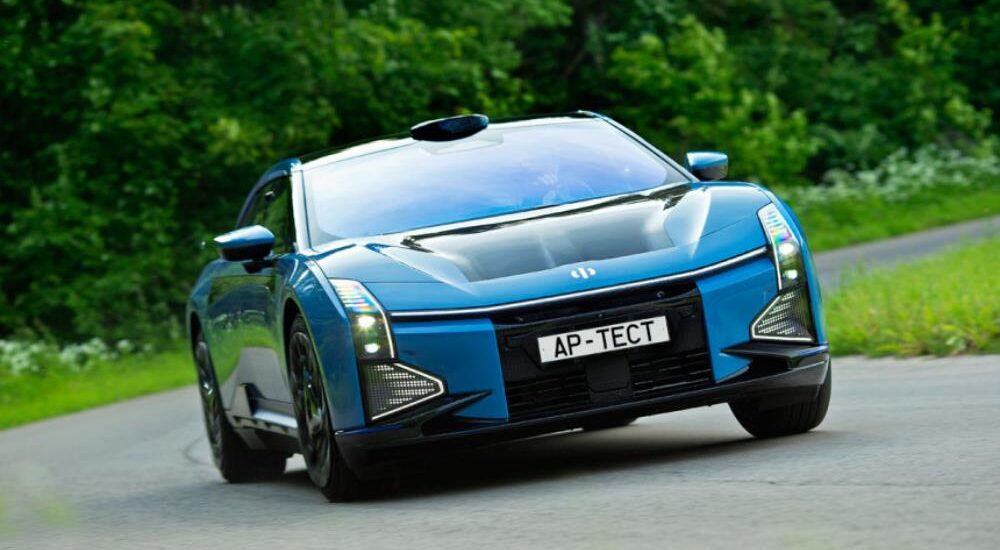KITT of the Twenty-First Century: HiPhi Z Super Sedan on the Test Track
Remember the famous car KITT from the TV series “Knight Rider”? Its full name is Knight Industries 2000, and it was a Pontiac Trans Am with a digital interior and artificial intelligence. It could talk, and it had an infrared scanner strip above the radiator grille. A real childhood dream! However, Pontiac never produced anything like that by the year 2000. Nearly a quarter of a century has passed since then, and here it is, a real-life KITT. An electric super-sedan from China, the HiPhi Z.
Instead of a red scanner eye, this car features real light screens on the doors and corners of the bumpers. You can display any message on the side screens, and on the bumper, there’s preset animation!
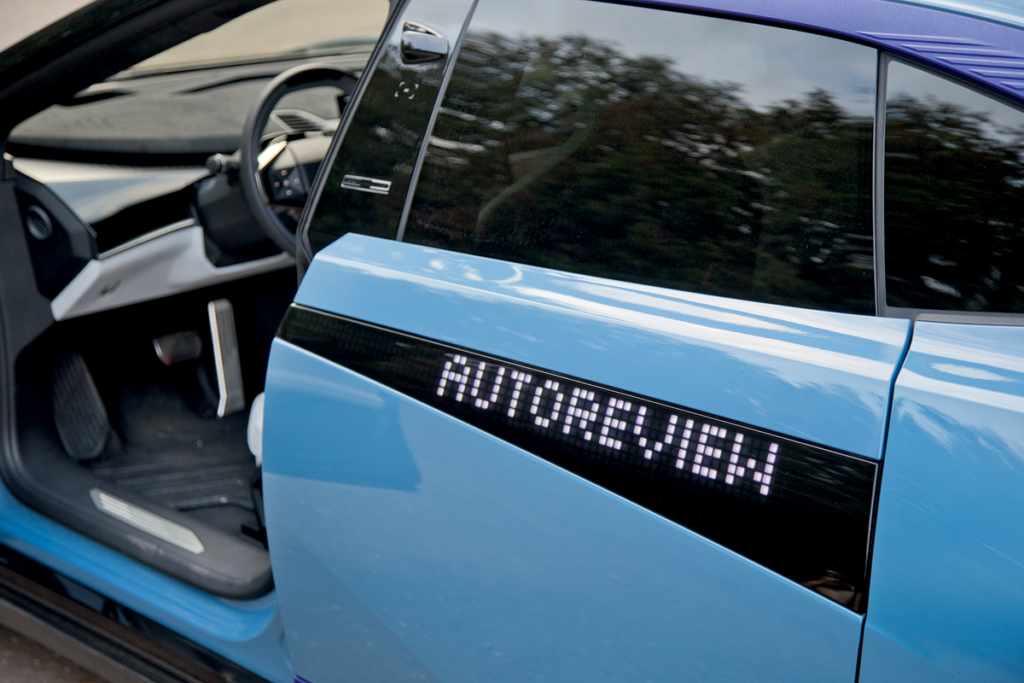
You can display any message on the side screens, but only in Latin characters – there are no Chinese hieroglyphs in the menu.
Moreover, this isn’t just a gimmick like cartoons with kittens and puppies; it includes useful signs featuring a walking pedestrian. You stop in front of a crosswalk, tap on the touchscreen, and a red pedestrian figure starts walking on the rear bumper, just like on modern trams. And in the front, you can signal approval not just with hazard lights but also by raising a large yellow thumbs-up. It’s like giving a “like” in real life!
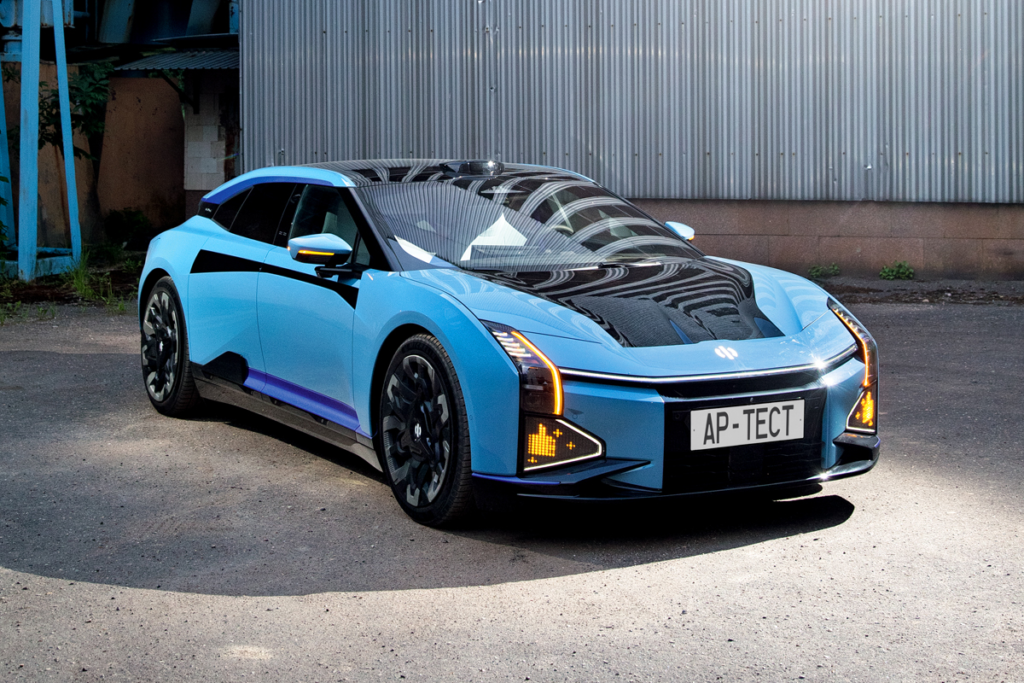
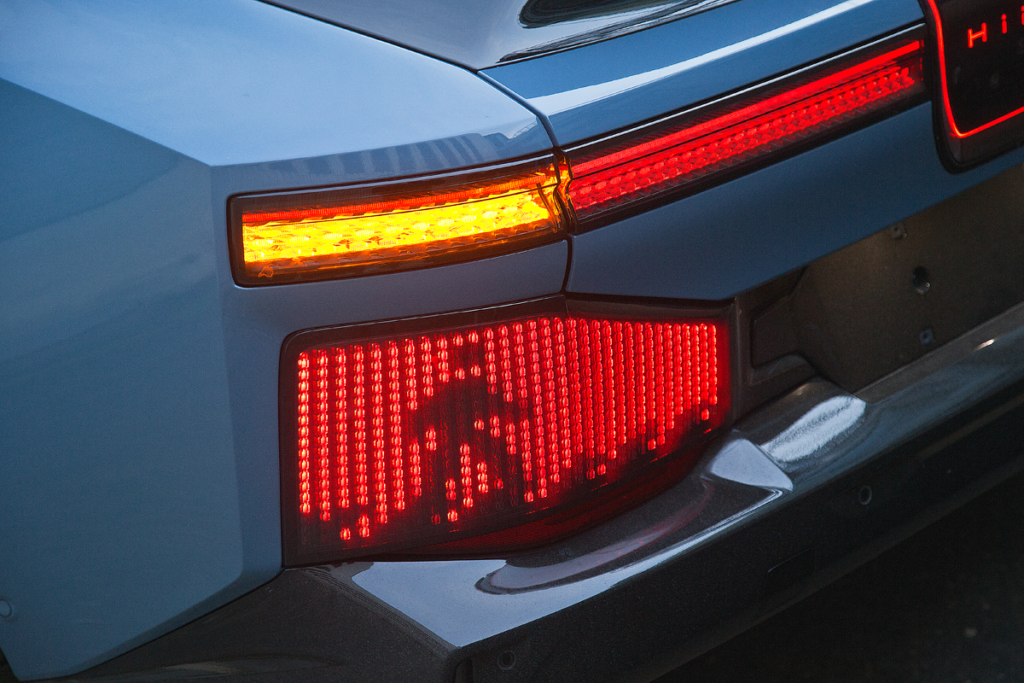
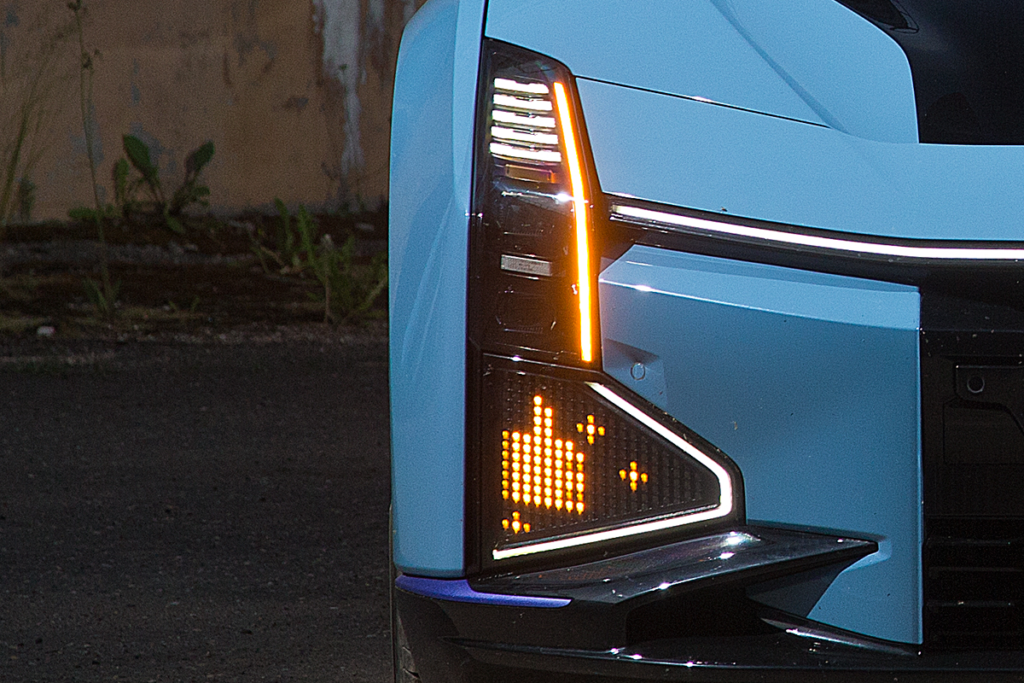
The company Human Horizons appeared six years ago, announcing its mission as creating new mobility: smart cars, smart cities, smart transportation. However, the plan’s implementation didn’t begin with mass-produced, affordable electric cars for everyone but rather with a full-blown luxury vehicle. The HiPhi X crossover quickly captured a quarter of the Chinese premium electric car market. Soon after, the Z sedan joined the lineup, and recently, another SUV named HiPhi Y arrived.
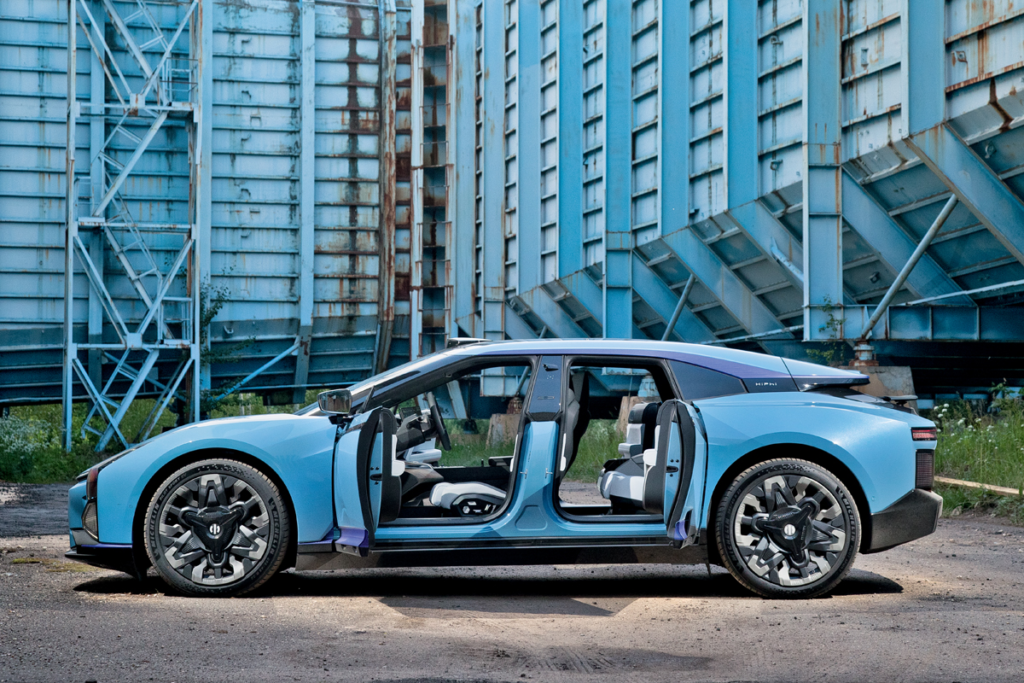
The doors, which open to 90 degrees, hide a very wide central pillar.
What sets the HiPhi Z apart? It doesn’t try to copy Tesla. It’s a true “hype-hi” car: among the vibrant new wave of Chinese electric cars like BYD Seal or Zeekr 001, it’s undoubtedly the most extravagant. Let’s say I wasn’t surprised by servo-driven doors after the Zeekr – although HiPhi doesn’t even have door handles, just an elongated button on the central pillar. The mechanism is even more leisurely, but if you wait, you’ll undoubtedly be impressed by the record-breaking opening angle. Additionally, the rear doors open 90 degrees – against the flow, like on a luxurious Rolls-Royce. Here, the central pillar is also preserved, and without it, creating a sufficiently rigid body with a massive and heavy floor-mounted battery is quite challenging. Its capacity is 120 kWh, but within a hundred kilometers of driving to the test track, I depleted two-thirds of it! Because the HiPhi Z encourages you to drive fast. And not just because this particular car doesn’t have license plates.
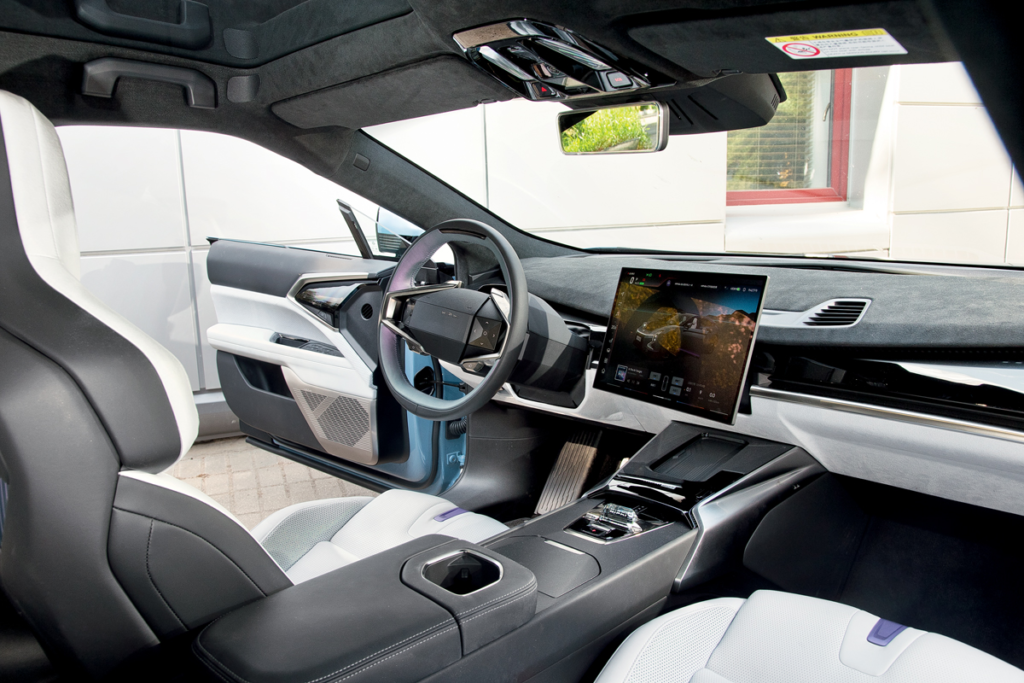
There is no separate instrument screen – the speed figures can be seen in the corner of the main display or with the help of a projection on the windshield.
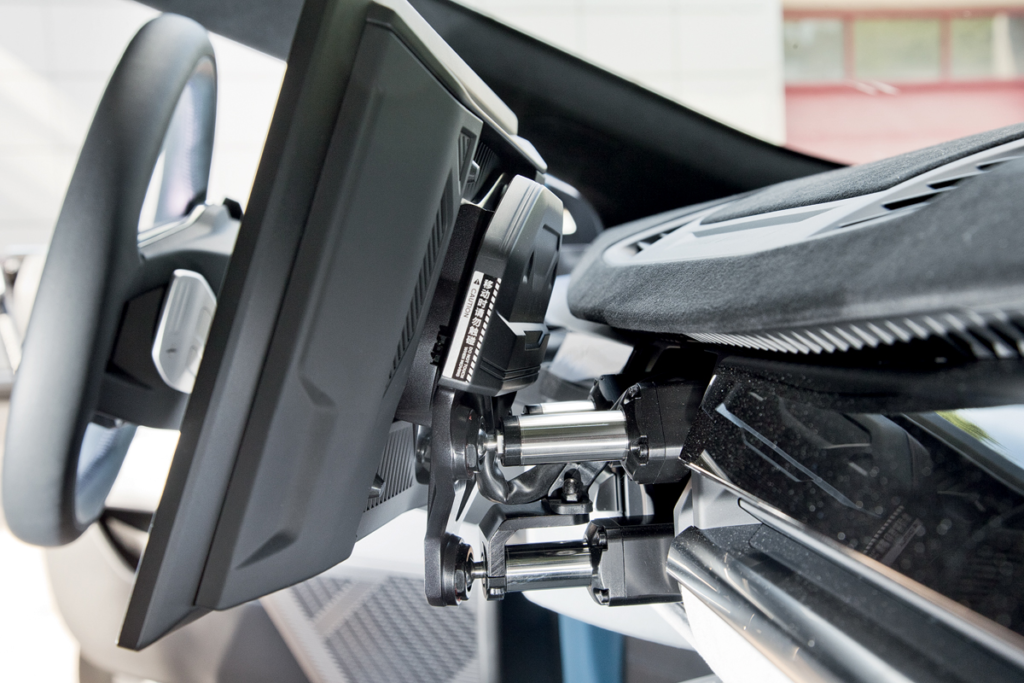
The open mounting and rotation mechanism of the screen evokes associations with the hypercar GMA T.50 by Gordon Murray.
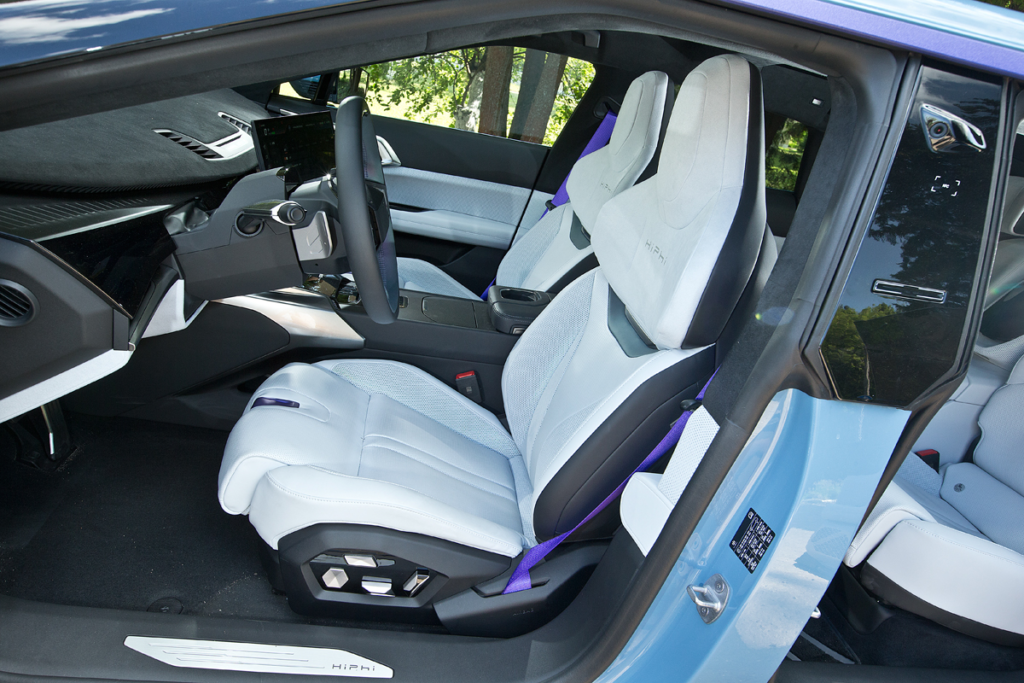
The front seats are of a successful shape, with a mass of adjustments, a massager, heating, and ventilation.
The first thing the driver encounters is the technocratic dashboard and the rotating central screen of the HiPhi Bot infotainment system. Look at those servo drive cylinders! They seem capable of holding the wing of a hypercar, pressed down by hundreds of kilograms of downforce.
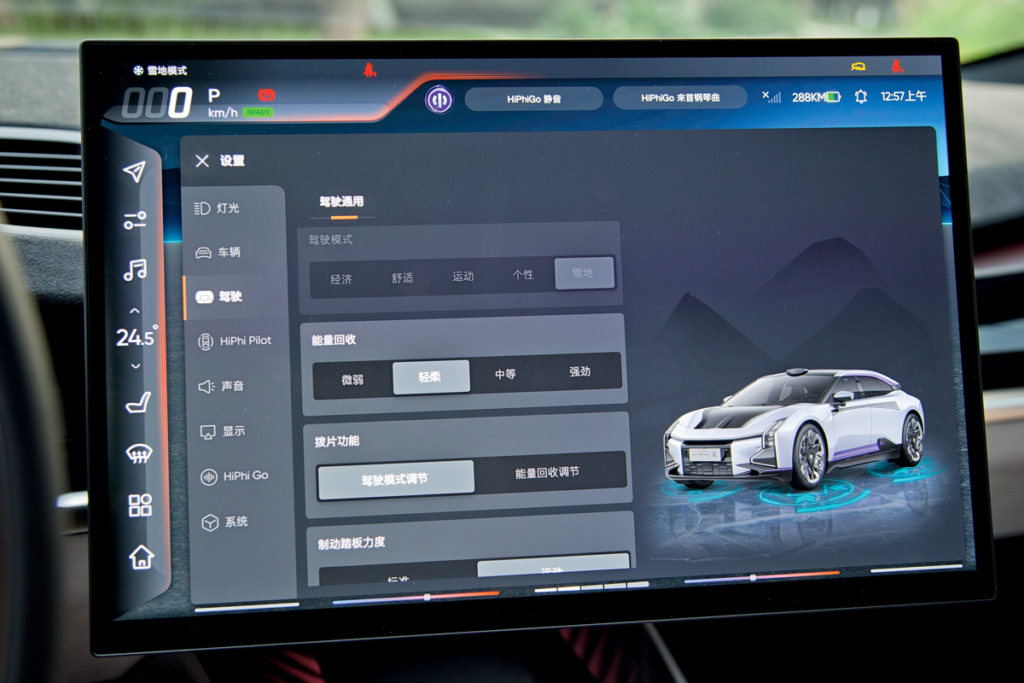
Even without knowing English, it’s easy to manage the chassis settings through the menu, thanks to the very clear graphics.
The menu logic is similar to that of all modern “Chinese” cars, and even the chassis settings options are in a similar order. So, after reading everything once with the help of an online translator, using it afterward is a breeze. I’ve never seen climate control settings illustrated so thoroughly before, and you can even rotate the image of the front panel.
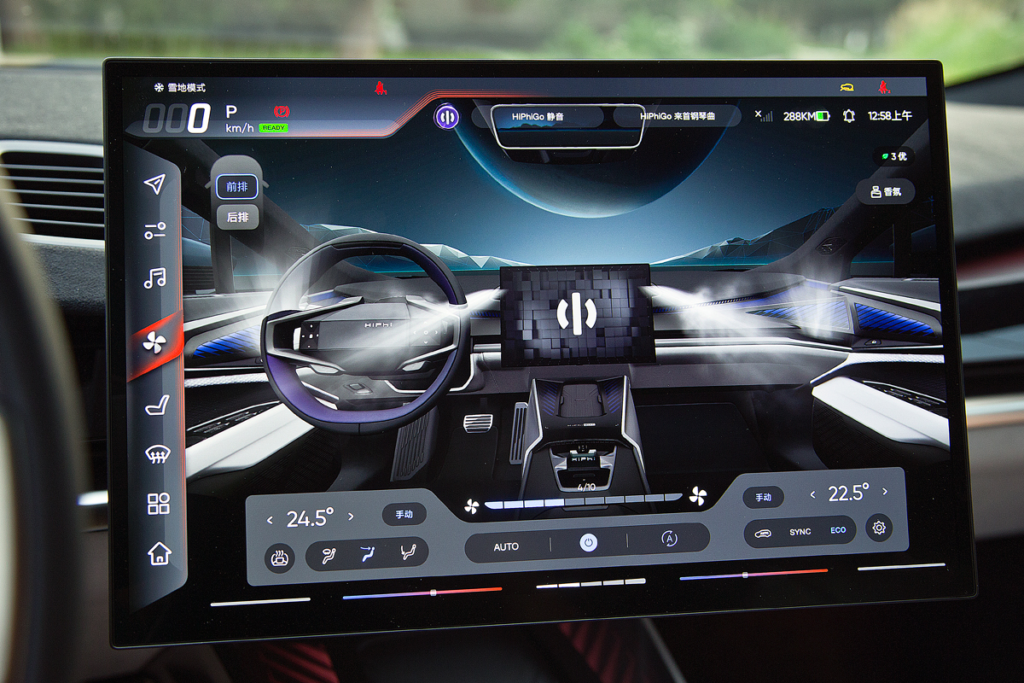
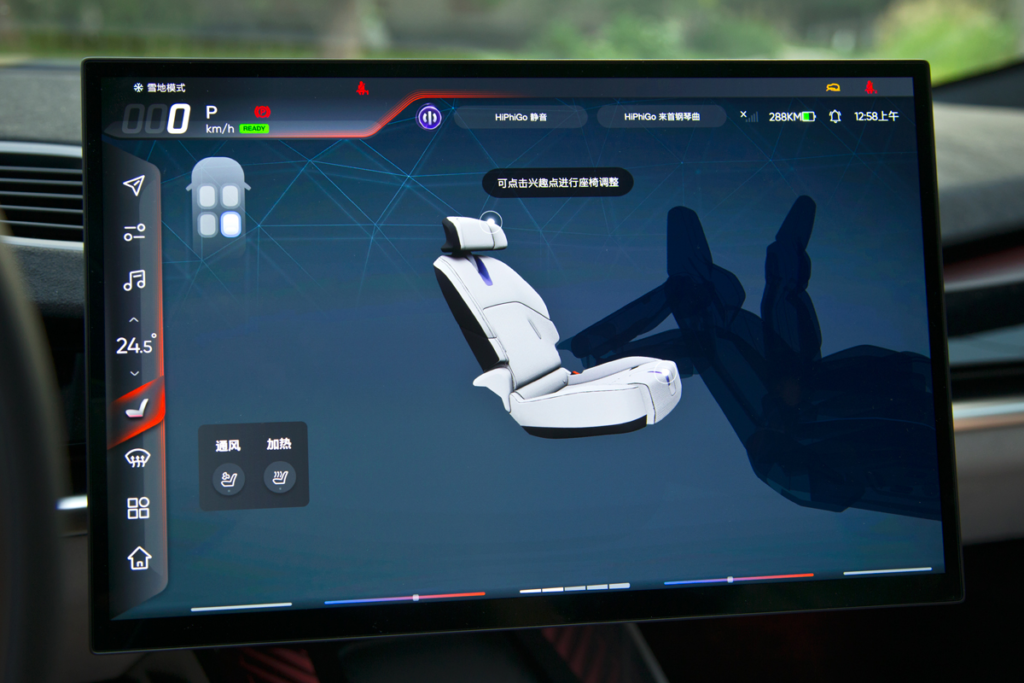
And how about the graphics on the home screen, which allows you to control the opening and closing of doors from any possible angle?

You can rotate the illustrated sedan to select the desired door and open it directly from the screen.
It’s even surprising to find familiar window control buttons and basic seat adjustment buttons in this interior. But there’s no steering wheel adjustment lever (hello, Tesla) – instead, there’s a separate quick settings menu option that lets you adjust the steering wheel using the button on the right spoke. By the way, it also resembles the steering wheel of that famous Pontiac from the movies.

KITT, let’s go! To make the resemblance complete, our photographer Dima Piterskiy even played music from the TV series, and the legendary synthesizer sounds that the supercar emitted while driving, HiPhi replicates perfectly in one of the acceleration sound options.

The steering hub looks like something from a future transportation vehicle. Thank you for keeping the wheel itself round.
By the way, don’t be deceived by the illustrations; the Zeekr might seem relatively compact, like an Octavia in a body kit. However, in reality, this sedan is as long as a Panamera, and in width, it surpasses the new Land Cruiser by five centimeters! But when you’re behind the wheel, you don’t notice this at all. Right from the first few hundred meters, the HiPhi establishes a pleasant and friendly connection with you, as if you’ve driven along the Yauza embankments together many times.
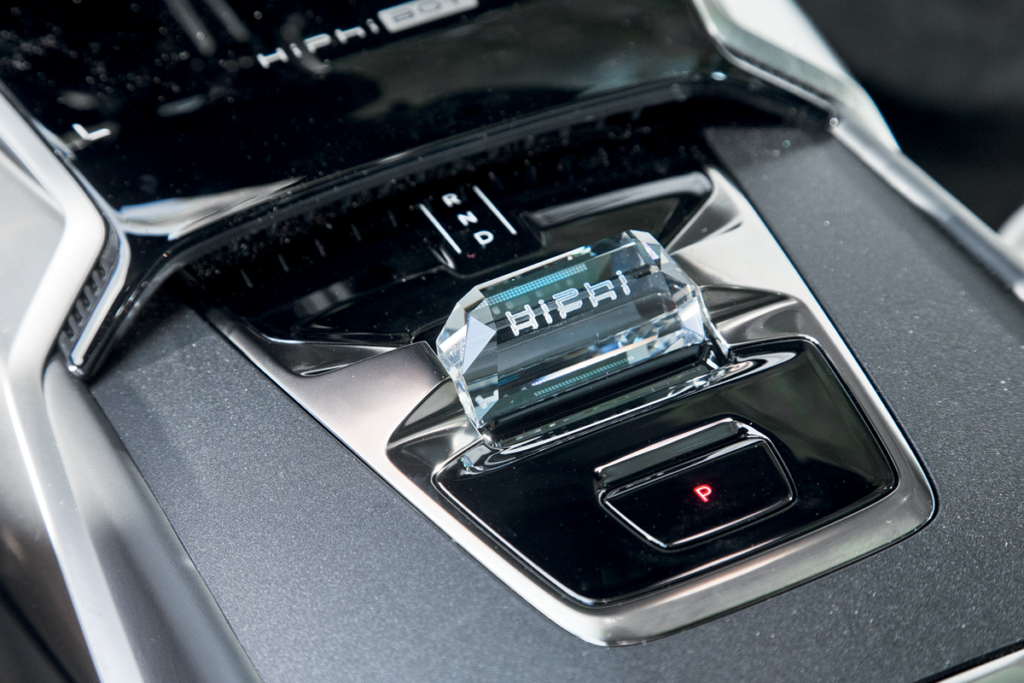
The “crystal” transmission joystick moves with a pleasant effort and is backlit from the inside.
It turns out that not all pedal configurations in electric cars are the same. Not too long ago, I complained that I didn’t like the accelerations of powerful “electric” cars because of the unpleasant sensations in my body. However, the HiPhi Z proved that you can be fast and polite. It has two electric motors with a total output of 672 hp and claims a 3.8-second sprint to “a hundred.” The declared dynamics are very similar to the Zeekr 001, but if the Zeekr left a somewhat queasy aftertaste, here everything went absolutely unnoticed and faster – a real 3.9 seconds to reach “a hundred” and 7.8 seconds to hit 150 km/h. However, the acceleration tops out at 197 km/h. After all, even a very capacious 120 kWh battery will deplete too quickly at this pace.
| Parametrs | HiPhi Z |
| Max. speed km/h | 197 |
| Acceleration time, s 0—60 km/h 0—100 km/h 0—150 km/h on 400m distance 60—100 km/h 80—120 km/h | 2,2 3,9 7,8 11,8 2,0 2,4 |
| Braking distance from a speed of 100 km/h, m⠀ | 34,5 |
| Curb weight, kg | 2565 |
| Weight distribution (front/rear axle), % | 50,3/49,7 |
| Ground clearance, mm | 113—158 |
Overall, I got the impression that the electric part of the “Zetka” is not very efficient, and the real coefficient of aerodynamic resistance is clearly higher than the specified 0.27. Or perhaps the frontal area is too large? Even during calm countryside driving, the HiPhi Z consumes about 25 kWh per 100 km, slightly more than the Zeekr. And if you step on it…
This is the best “Chinese” car I’ve ever driven!


HiPhi Z is adorned with elegant fittings – only the standard window buttons do not match the overall mood.
Regarding throttle response, as I mentioned earlier, using the right pedal is a pleasure, and in the city, you can exclusively operate with it. There are four levels of regenerative braking, and even the most aggressive one doesn’t bother passengers with abrupt transitions: the tuning of transitional processes is excellent.
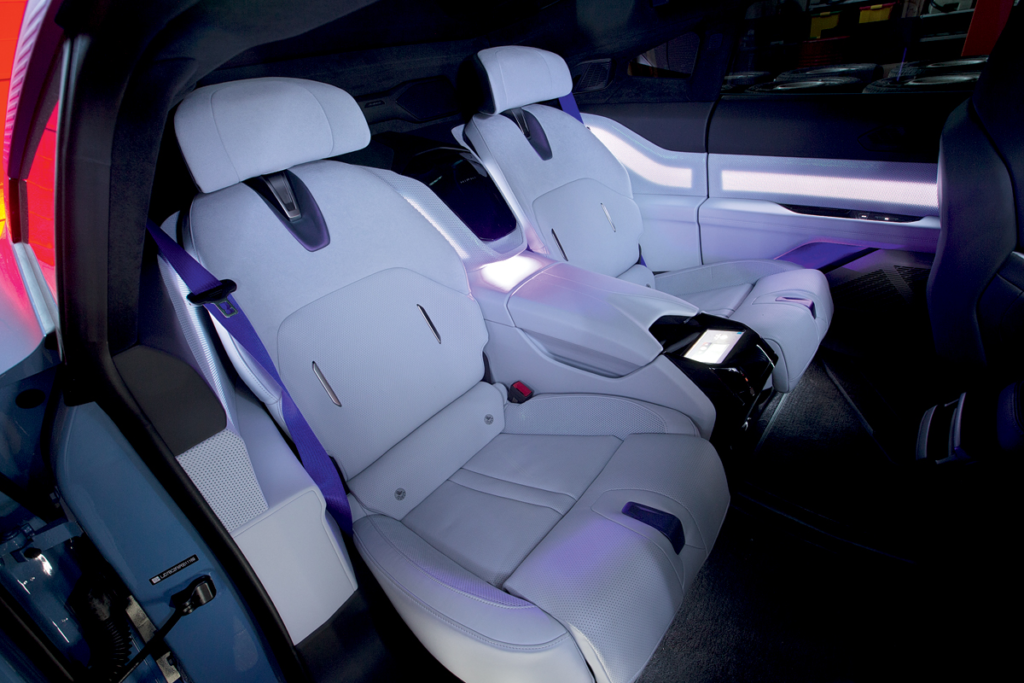

In the dark, the passenger part of the cabin is especially cozy. There is no rear window, but there is a panoramic roof that extends beyond the collar, and there are additional windows on the sides. But tall people in the back won’t like the low cushion and head hits on the roof during bumps.
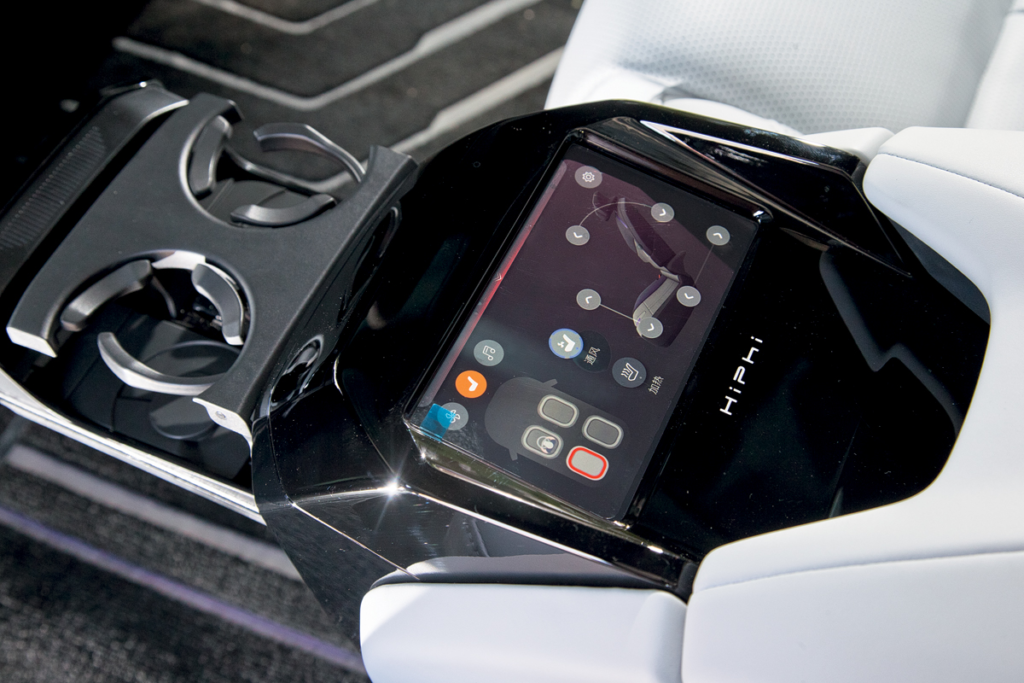
The tablet for rear passengers is unexpectedly modest in size and menu visualization.
And the left pedal is exemplary. Late in the evening when I returned the HiPhi, I realized that I had only paid attention to it once during the entire day – during the brake distance measurements. This means that in standard modes, there were no questions about the quality and level of deceleration. And the result for a heavy (2565 kg on our scales) electric car is excellent – 34 meters. Much of this is thanks to the 22-inch Michelin Pilot Sport EV tires. They’re quiet, grippy, and beautiful (just look at those velvety inserts on the sidewalls), and they make a significant contribution to the driving character of the “Zetka.”
Yes, indeed, it’s here! And what a car it is.

The rear doors need to be closed with buttons on the ceiling – it’s almost impossible to reach the handles from deep recesses.
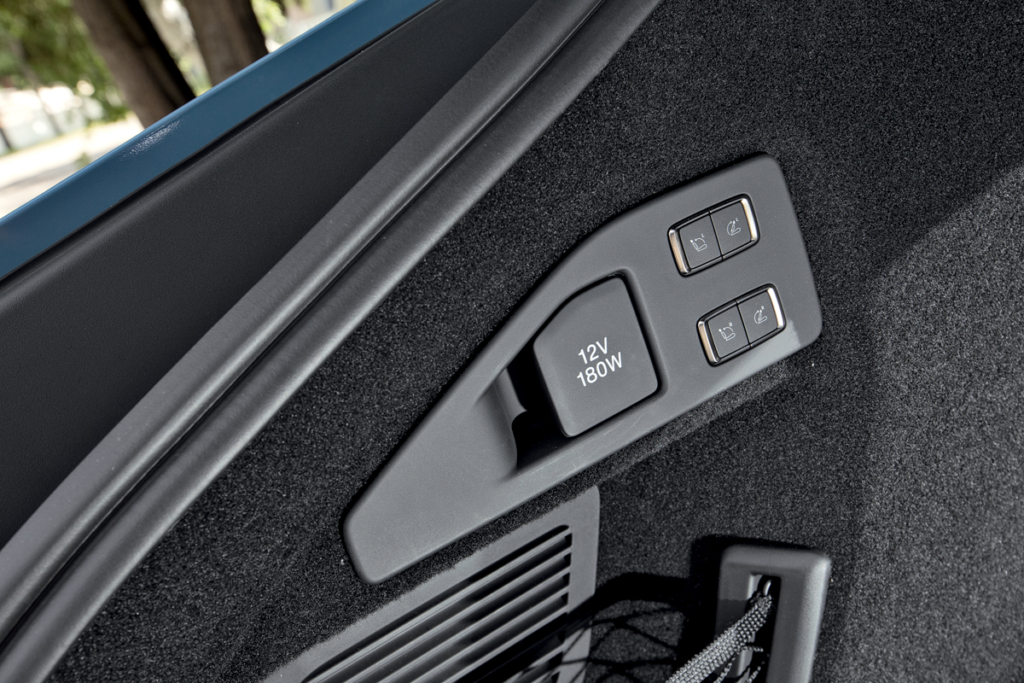
The servo drive for folding the rear seat – in a sedan! However, in the four-seat interior variant, the central section is solid.
The HiPhi platform features a complex aluminum air suspension. The front suspension with a double wishbone layout and a single upper arm resembles the Mercedes setup, while the rear multi-link suspension is now the gold standard for all premium manufacturers. The quality of execution, ball joint sizes, and the level of engineering are impressive. Continental provides the air struts, and all other suspension components bear only original HiPhi part numbers that don’t cross over with anything else. The Zeekr had a similar setup, but if that one left the impression of a product that’s not quite finished, the Z is ready.
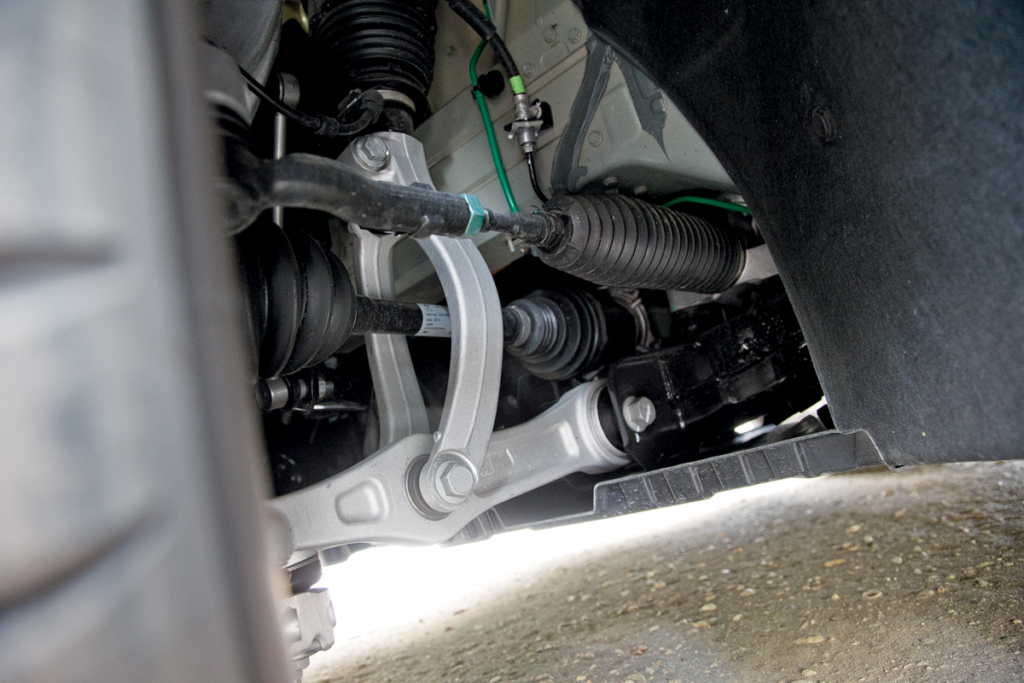
All-round aluminum suspensions – look at how elegantly the front suspension with double transverse arms is executed.
The fact that the fast straight line is its natural habitat is expected, especially since the relatively low top speed doesn’t challenge the chassis. Even if there are ruts or irregularities on the road, the HiPhi Z stays true to the chosen direction. And the desire to change direction has become a pleasant bonus. The “Zetka” surprisingly has matured steering without unnecessary sharpness in the near-zero zone, a trait often found in Chinese super-electric cars. The responses are equally clear both on a smooth highway bend and on a twisty backroad. It’s a pity I couldn’t test the reactive action to the max – it’s noticeably better than the Zeekr, but only the lightest setting is close to reality among the three modes. And it’s still far from the Taycan.
But that’s just it!

Up front, it’s more like a glove compartment than a trunk – after all, there is no traditional glovebox in the cabin.
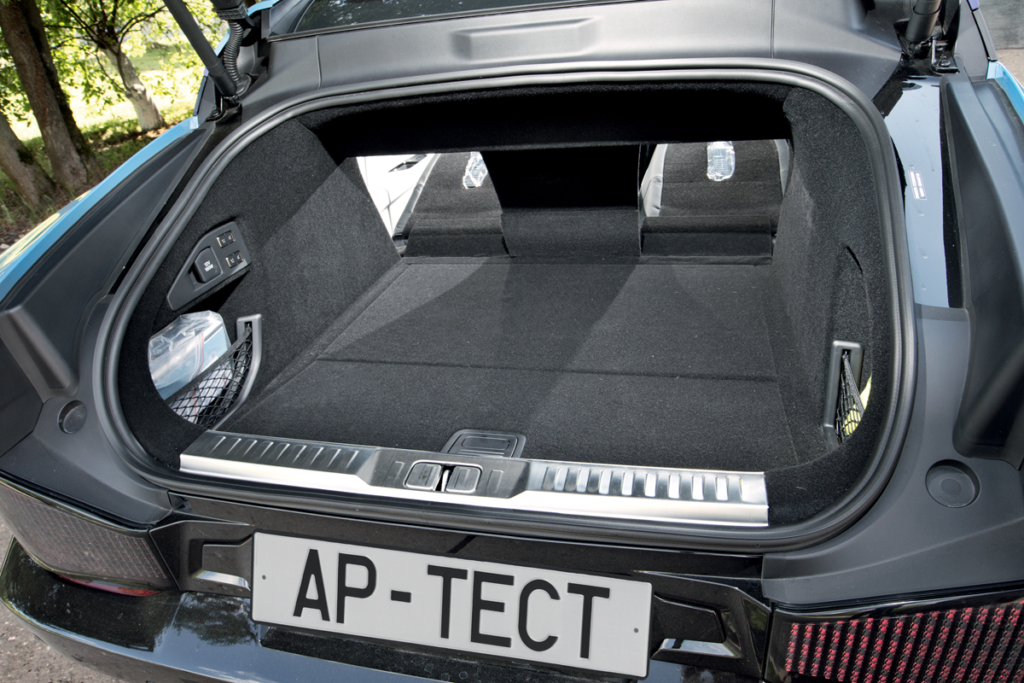
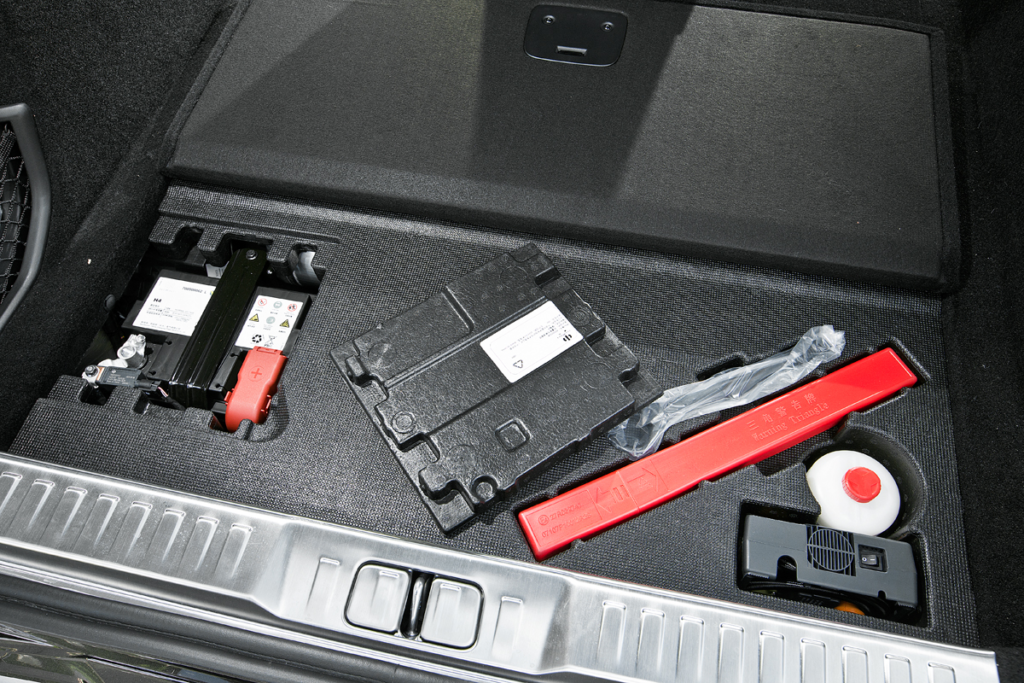
The loading height fell victim to the design, and the trunk volume could have been larger given the external dimensions.
These precise and clear responses, with a slight resistance on entry and a logical transition in extreme turns, are the true companions of a well-tuned chassis. No antics with unexpected deep slides or a two-step turn, like the Zeekr. Even if you catch a bump or an undulation in the corner, the HiPhi maintains its trajectory perfectly. The shocks have three modes, but even the comfort setting doesn’t suffer from looseness or rocking and manages to keep the huge wheels from vibrating on sharp bumps. The Normal position is for consistently good roads, where it already starts to detail the road surface. As for the sport mode, it’s so stiff that it’s only useful on a track. But HiPhi has no business on the track: it’s heavy and clearly “insufficient.” It’s good and safe in real life, but on a racing track, you want more excitement. Some torque vectoring would be perfect here! Especially with such powerful electric motors. But alas, with the traction control turned off, the HiPhi Z becomes even more “bland,” clearly drifting towards the outer edge.

At the intersection, the large and heavy HiPhi was able to reach 81 km/h! The limit was the drift when returning to its lane. Sliding the rear wheels is a taboo for the “Zetka,” the stability control system works gently.
This isn’t a sports car but a large and fast Gran Turismo sedan. In terms of ride smoothness, it’s only slightly inferior to the Mercedes EQE, and in terms of acoustic comfort, HiPhi is just as good. Inside the cabin, you can’t hear anything except your quiet conversation with the passengers – or the music from the 23 speakers of the Meridian audio system.
Wait, isn’t Meridian the traditional supplier of audio systems for Jaguar and Land Rover cars?
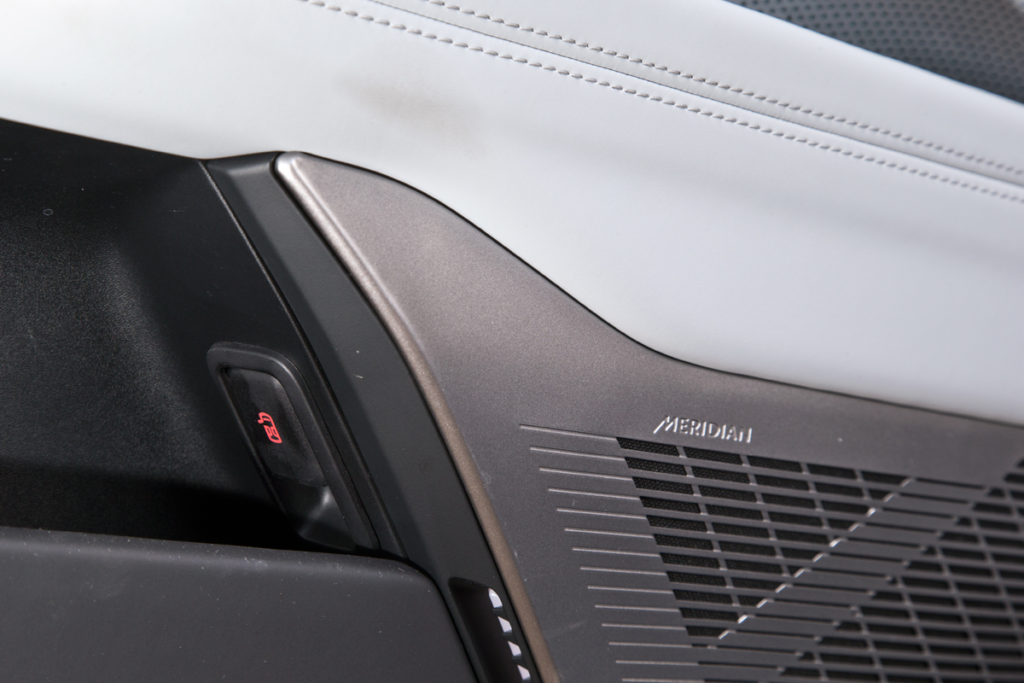
That’s right because HiPhi is essentially the Jaguar of the future. If not in terms of design, then in terms of driving characteristics. Meet Mark Stanton, a former engineer at Ford and JLR, the head of Jaguar’s SVO (Special Vehicles Operations) division, and since 2017, the head of engineering at HiPhi. When he joined this startup, there were only 50 employees, but among hundreds of similar projects, his background as a leader attracted attention. HiPhi’s CEO, David Ding, was the president of General Motors’ Shanghai division and knows the industry inside out. He also understands that not everything in this field is decided by LED lights in the bumpers. Stanton was given a carte blanche for chassis tuning, and he invited Peter Davis, a 62-year-old Jaguar veteran and representative of the old school of vehicle tuning, as an expert on driving dynamics. It’s no coincidence that in his interviews, Davis emphasizes the importance of steering feel.
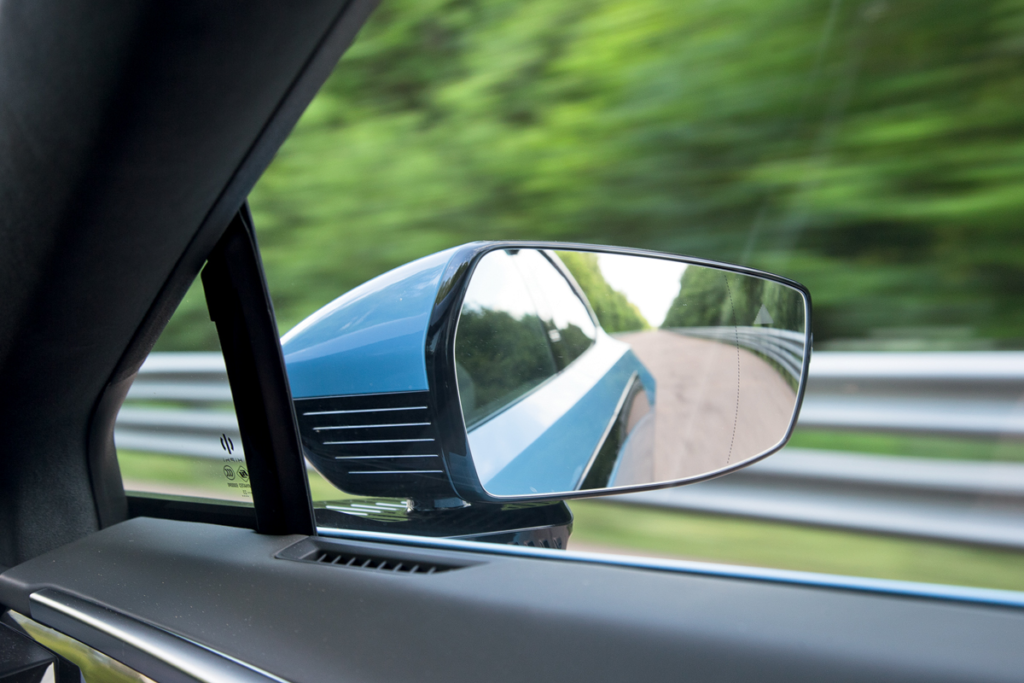
Frameless rearview mirrors are beautiful and convenient. I wonder how they’ll handle slush?
Perhaps this is the secret of the HiPhi Z? Progressive Chinese designers who live and think about the future, alongside conservative engineers from the old continent where HiPhi is about to arrive. Prices in Germany and Norway are already known: the HiPhi X crossover has been certified and is priced from 109,000 to 123,000 euros, while the Z sedan with a five-seat interior starts at 105,000 euros. Opting for the coupe version with two separate seats costs just an additional two thousand euros. The Porsche Taycan 4S, which is comparable in terms of performance, is five thousand euros more expensive – and that’s just the starting price. If you equip it to the HiPhi’s level, you’ll need to add another third of its price. The Audi e-tron GT is similarly priced.
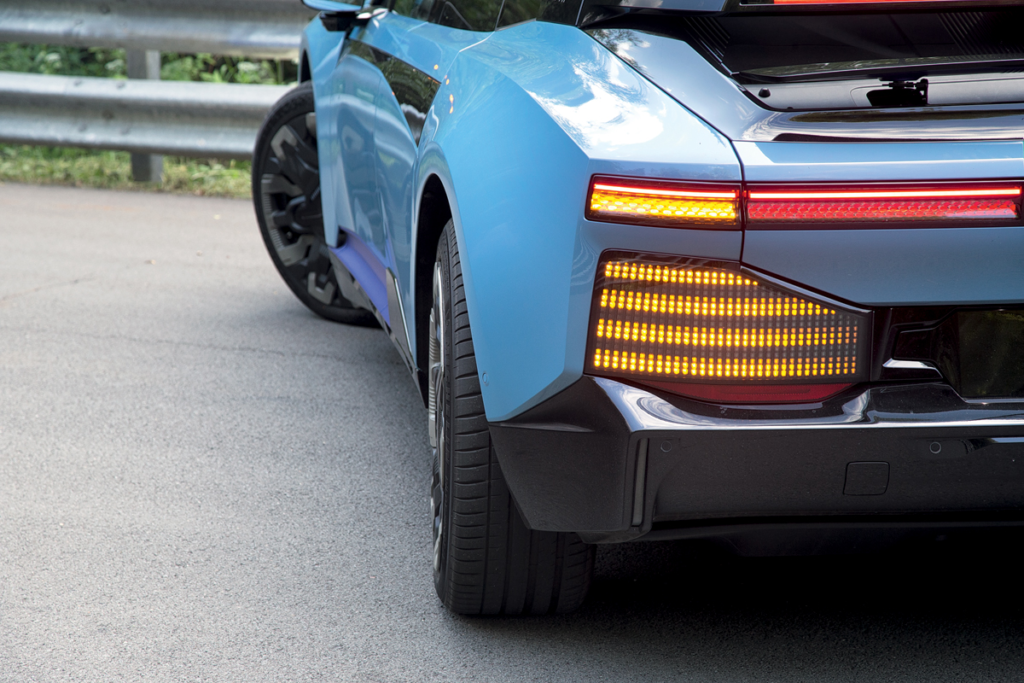
The combined mobility of the rear-wheel steering is as much as 13 degrees – more than the new S-Class!
The company Autotrader, which provided us with this “Zetka,” is offering it for 10.8 million rubles. That’s quite a reasonable price – most sellers import HiPhi Z to order for 11-12 million. But the Taycan 4S is still 2-3 million more expensive. It will be interesting to see the sales statistics at the end of the year. And to conduct a comparative test with Porsche or Audi – to find out who the true “knight of the road” is in this company. But it’s already evident that covering four thousand LEDs in HiPhi’s bumpers is something the German premium brands currently can’t match.

| Car | HiPhi Z |
| Mesurments, mm Length Width Height Wheelbase | 5036 2018 1439 3150 |
| Trunk volume, l | 316—654* |
| Curb weight, kg | 2539 |
| Drag coefficient, Cd | 0,27 |
| Traction motor type | Synchronous, on permanent magnets |
| Traction motor location | Transversely over the front and rear axles |
| Max. power, hp/kW | 672/494 |
| Max. torque, Nm | 820 |
| Traction battery type | Lithium-ion with a capacity of 120 kWh⠀ |
| Drive unit | four-wheel drive, with an individual electric motor on each axle |
| Front suspension | Independent, pneumatic, four-lever |
| Rear suspension | Independent, pneumatic, multi-link |
| Wheel dimension | 255/45 R22 front, 285/40 R22 rear |
| Max speed, km/h | 200*** |
| Acceleration time 0—100 km/h, s⠀ | 3.8 |
| WLTP cycle reserve, km | 555 |
*With rear seats folded down
** Limited by electronics
Photo: Dmitry Pitersky
This is the translation. You can read the original article here: KITT двадцать первого века: суперседан HiPhi Z на дорогах полигона

